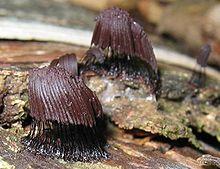| Stemonitis | |
|---|---|
 | |
| Stemonitis fusca or similar species in the White Mountain National Forest | |
| Scientific classification | |
| Domain: | Eukaryota |
| Phylum: | Amoebozoa |
| Class: | Myxogastria |
| Order: | Stemonitidales |
| Family: | Stemonitidaceae |
| Genus: | Stemonitis Gled. [1] |
| Type species | |
| Stemonitis fusca | |
Stemonitis is a distinctive genus of slime moulds found throughout the world (except Antarctica). They are characterised by the tall brown sporangia, supported on slender stalks, which grow in clusters on rotting wood.[2] The genus was first described by German botanist Johann Gottlieb Gleditsch in 1753. A 2014 estimate suggests that there are 18 species in the genus.[3] Identification within the genus is difficult, and can only be performed with confidence using a microscope or by DNA sequencing. A fossil specimen is known from the Mid Cretaceous (99 ma) Burmese amber.[4]
Species
The following species are accepted by Species Fungorum:[5]
- Stemonitis axifera (Bull.) T.Macbr. (1889)
- Stemonitis farrensis T. N. Lakh. & Mukerji (1977)
- Stemonitis ferruginea Ehrenb. (1818)
- Stemonitis flavogenita E. Jahn (1904)
- Stemonitis foliicola Ing (1967)
- Stemonitis fusca Roth (1787)
- Stemonitis graciliformis Nann.-Bremek., Mukerji & Pasricha (1984)
- Stemonitis herbatica Peck (1874)
- Stemonitis inconspicua Nann.-Bremek. (1966)
- Stemonitis laxifila Nann.-Bremek. & Y. Yamam. (1988)
- Stemonitis lignicola Nann.-Bremek. (1973)
- Stemonitis marjana Y. Yamam. (2000)
- Stemonitis mediterraneensis H.H. Doğan & Eroğlu (2014)[3]
- Stemonitis mussooriensis G. W. Martin, K. S. Thind & Sohi (1957)
- Stemonitis nigrescens Rex (1891)
- Stemonitis pallida Wingate (1899)
- Stemonitis rhizoideipes Nann.-Bremek., R. Sharma & K. S. Thind (1984)
- Stemonitis smithii T.Macbr. (1893)
- Stemonitis splendens Rostaf. (1875)
- Stemonitis virginiensis Rex (1891)
References
- ^ a b "Genus Record Details: Stemonitis Gled., Method. Fung.: 140 (1753)". Species Fungorum. CAB International. Retrieved April 12, 2012.
- ^ Gary Emberger (2008). "Stemonitis sp". Messiah College. Retrieved April 13, 2012.
- ^ a b Doğan HH, Eroğlu G (2014). "A new Stemonitis species from Turkey". Mycotaxon. 129 (2): 293–296. doi:10.5248/129.293.
- ^ Rikkinen, Jouko; Grimaldi, David A.; Schmidt, Alexander R. (December 2019). "Morphological stasis in the first myxomycete from the Mesozoic, and the likely role of cryptobiosis". Scientific Reports. 9 (1). doi:10.1038/s41598-019-55622-9. ISSN 2045-2322.
- ^ "Stemonitis". Species Fungorum. CAB International. Retrieved April 12, 2012.
External links